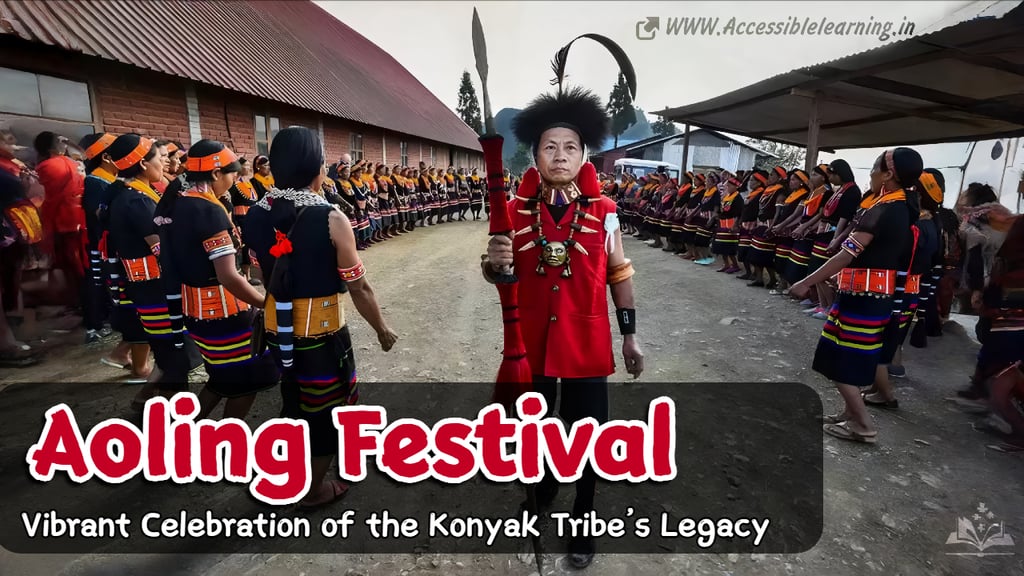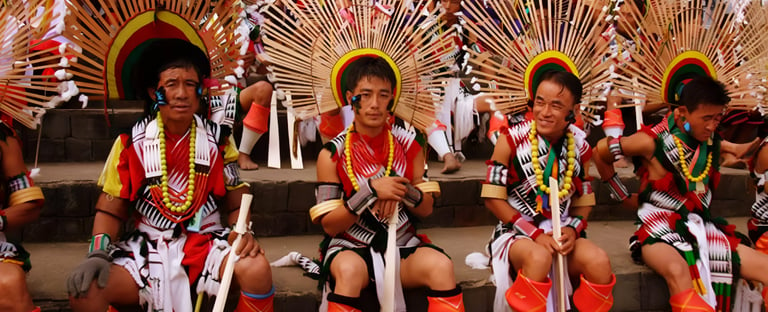
The Aoling Festival: Traditions, Rituals, and Cultural Significance
Discover the Aoling Festival, the vibrant cultural celebration of the Konyak tribe in Nagaland, India. Learn about its history, rituals, traditional dances, feasts, and spiritual significance. Explore how this festival marks the new agricultural season while preserving the rich heritage of one of Nagaland’s most fascinating tribes.
CULTURE/TRADITIONEVENT/SPECIALINDIA/BHARATCELEBRATION/FESTIVALSEDUCATION/KNOWLEDGE
Keshav Jha
4/1/20254 min read


The Aoling Festival is a vibrant and culturally rich festival celebrated by the Konyak tribe of Nagaland, India. This annual festival, held in the first week of April, marks the beginning of a new year and the onset of the sowing season. The Konyaks, known for their warrior traditions and unique customs, showcase their heritage through dance, music, and rituals during this grand celebration.
Significance of Aoling Festival
The Aoling Festival is deeply rooted in agricultural traditions and spiritual beliefs. It is celebrated to appease Apo Angh, the supreme deity, seeking blessings for a bountiful harvest, prosperity, and protection from evil spirits. The festival also serves as a time for community bonding, where different generations come together to strengthen social ties and preserve their heritage.
When and Where is Aoling Celebrated?
The festival takes place annually from April 1st to April 6th across various villages of the Konyak tribe in Mon district, Nagaland. Each village has its unique way of celebrating, but the core essence remains the same—welcoming the new year with enthusiasm and cultural pride.


Rituals and Celebrations of Aoling Festival
The festival unfolds over six days, each having a specific significance:
Day 1 & 2: Preparation Days (Nyang Wansan & Nyang Ai)
The initial days are dedicated to cleaning homes, preparing traditional rice beer, and collecting firewood for the grand celebrations. People repair their homes, craft new decorations, and start making traditional garments and ornaments for the festival.
Days 3 & 4: The Main Festivities (Lingnyu & Lingha Nyih)
These days witness the most vibrant festivities, including traditional dances, folk songs, and warrior displays.
Men and women dress in traditional attire, with men wearing headgears adorned with wild boar tusks and feathered spears.
The iconic war dance is performed, symbolizing the tribe’s valor and history of headhunting, a practice that has now been abandoned.
Animal sacrifices are made to invoke blessings from the gods for a prosperous year.
Feasting begins, with families preparing large meals that include smoked meats, rice, and local delicacies.
Young men and women engage in traditional games and sports, including wrestling and spear-throwing contests, showcasing their strength and agility.
Day 5: Fun and Feasting (Lingnyu Nyih)
A grand feast is prepared with traditional food, including smoked pork, bamboo shoot dishes, and rice beer.
Community members share meals, strengthening unity and harmony.
Villagers sing ancient folk songs, telling tales of their ancestors and warrior legends.
Elders share wisdom and stories with the younger generation to pass down knowledge and tribal history.
Day 6: Conclusion and Prayers (Lingshan Nyih)
The final day is more spiritual, with prayers and rituals marking the end of the festival.
The villagers bid farewell to the celebrations with hope for a fruitful year ahead.
Offerings of rice, meat, and beer are made to the spirits, and a collective prayer is performed.
A symbolic farewell dance is performed, wishing prosperity and harmony to all.
Cultural Elements of Aoling Festival
Traditional Attire: The Konyak men and women wear colorful handwoven shawls, beaded necklaces, and brass ornaments.
Music and Dance: Folk songs and rhythmic dances reflect warrior traditions, love stories, and folklore.
Community Bonding: The festival strengthens relationships and offers an opportunity for storytelling and knowledge sharing.
Art and Craftsmanship: Konyak artisans showcase their skills in wood carving, beadwork, and metal crafting during the festival.
Tourism and Aoling Festival
The Aoling Festival has gained popularity among tourists, offering a rare glimpse into the indigenous culture of Nagaland. Visitors can witness:
Authentic tribal dances and rituals
Handicraft and traditional weaponry exhibitions
Interaction with local tribespeople and their unique way of life
Participation in local games and cultural exchanges
Exploration of Mon district’s breathtaking landscapes, including hills, rivers, and traditional Konyak homes
The Declining Traditions and Revival Efforts
With modernization, the traditional aspects of the Aoling Festival face challenges, as younger generations move to cities for education and jobs. However, efforts are being made to revive and preserve the cultural significance of the festival through
Government and local NGO initiatives promoting cultural tourism.
Schools and institutions incorporating tribal history and traditions into their curriculum.
Social media and digital platforms showcasing the beauty of the Aoling Festival to a global audience.
The Aoling Festival is not just a celebration but a cultural legacy of the Konyak tribe. It beautifully blends traditions, rituals, and community spirit, making it one of the most significant festivals of Nagaland. If you seek an immersive cultural experience, visiting Nagaland during the Aoling Festival is a journey into the heart of tribal heritage. The festival continues to be a symbol of resilience, identity, and unity for the Konyak people.
FAQs
Who celebrates the Aoling Festival?
The Konyak tribe of Nagaland, India.
What is the main purpose of the Aoling Festival?
It marks the beginning of the agricultural season and seeks blessings for prosperity.
Where can one experience the best Aoling celebrations?
The Mon district of Nagaland offers the most authentic experience.
Can tourists participate in the Aoling Festival?
Yes, tourists are welcome to witness and enjoy the celebrations.
How can one reach Mon district for the festival?
The nearest airport is in Dibrugarh, Assam, followed by a road journey to Mon, Nagaland.
What should tourists keep in mind when visiting the festival?
Respect local traditions, seek permission before taking photographs, and engage with the community in a culturally sensitive manner.
Subscribe To Our Newsletter
All © Copyright reserved by Accessible-Learning Hub
| Terms & Conditions
Knowledge is power. Learn with Us. 📚


